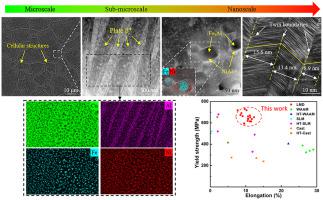Additive Manufacturing ( IF 11.0 ) Pub Date : 2021-01-07 , DOI: 10.1016/j.addma.2020.101825 Boyuan Li , Han Zheng , Changjun Han , Kun Zhou

|
Laser metal deposition (LMD) additive manufacturing was utilized to fabricate a Cu‒9Al‒5Fe‒5Ni alloy with a hierarchical microstructure and superior mechanical strength. An optimized processing window of LMD was established for printing the alloy with a relative density greater than 99% using laser power of 1000–1500 W, scanning speed of 0.5–1.5 m/min and hatch space of 1.5–2 mm. The LMD-printed alloy exhibited a microstructure consisting of a martensite β* phase, a Widmanstätten α phase, Fe3Al and NiAl nanoprecipitates, and nanotwins. The hierarchical microstructure comprising microscale cellular structures, sub-microscale grains, and nanoscale precipitates and twins was achieved. The cellular structures were formed by the martensite β* and α phases. The nanotwins were formed at the interface of the plate-like β* phase, which was induced by the low stacking fault energy of the alloy and high cooling rate of LMD. The Fe3Al precipitates were formed within the β* and α phases, while the NiAl precipitates were distributed in the β* phase. The yield strength, ultimate strength, and elongation of the LMD-printed alloy were 593–713 MPa, 769–949 MPa, and 10–12%, respectively. The yield strength of the LMD-printed alloy was 160% and 76% higher than that of the counterparts fabricated by casting and wire arc additive manufacturing, respectively, which was attributed to the synergistic effects of the underlying mechanisms including the Hall-Petch type strengthening, dislocation strengthening, precipitation strengthening, and solid solution strengthening. These findings validated the applicability of LMD for printing the Cu‒9Al‒5Fe‒5Ni alloy and facilitated the potential applications in marine and offshore industries.
中文翻译:

通过激光金属沉积相加制备的Cu‒9Al‒5Fe‒5Ni合金的含纳米孪晶的组织和优异的机械强度
利用激光金属沉积(LMD)增材制造技术来制造具有层级微观结构和优异机械强度的Cu‒9Al‒5Fe‒5Ni合金。建立了LMD的优化处理窗口,以使用1000-1500 W的激光功率,0.5-1.5 m / min的扫描速度和1.5-2 mm的影线间距打印相对密度大于99%的合金。LMD印刷的合金具有由马氏体β*相,Widmanstättenα相,Fe 3组成的微观结构。Al和NiAl纳米沉淀和纳米孪晶。实现了包括微观尺度的细胞结构,亚微观尺度的晶粒,纳米尺度的沉淀物和孪晶的分层微观结构。孔结构由马氏体β*和α相形成。纳米孪晶形成于板状β*相的界面,这是由于合金的低堆垛层错能和LMD的高冷却速率引起的。铁3在β*和α相中形成了Al析出物,而在β*相中分布了NiAl析出物。LMD印刷合金的屈服强度,极限强度和伸长率分别为593-713 MPa,769-949 MPa和10-12%。LMD印刷合金的屈服强度分别比铸造和电弧增材制造的屈服强度高160%和76%,这归因于包括Hall-Petch型强化在内的基本机制的协同效应,位错强化,沉淀强化和固溶强化。这些发现证实了LMD在印刷Cu 9 Al 5 Fe 5 Ni合金中的适用性,并促进了在海洋和海上工业中的潜在应用。



























 京公网安备 11010802027423号
京公网安备 11010802027423号